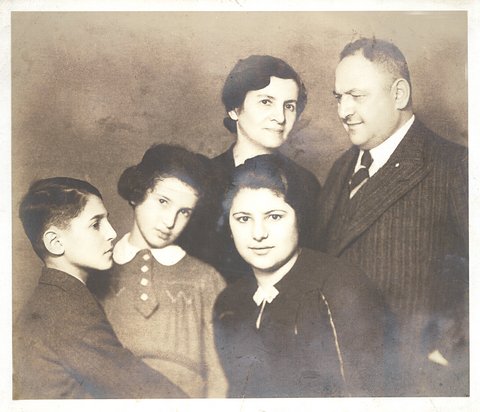The Freisings --- family traces
Carl Freising, born in Sulzbürg on September 28, 1886, was the firstborn of Simon (1857-1941) and Doris Freising, née Hellmann (1860-1925). In the following years, the couple had six children, four boys and two girls: Gustav in 1888, Julius in 1890, Siegfried in 1891, Benno in 1893, Ida in 1895, and Thekla in 1900, all of which attended the Jewish school in Sulzbürg.
His father Simon had already been a businessman in Freystadt and Sulzbürg, and successfully ran a hardware and tableware shop. In 1897 Simon acquired a property for 7,500 reichmarks on number 90 in Sulzbürg, comprised of a house, a stable, a barn, a farmyard, and an orchard.
All his children were drafted for World War I, but only three returned. Siegrfried was already dead by October 1914, and Benno, the youngest, ultimately committed suicide in 1916.
Carl himself received the Iron Cross. He wedded Irma Kaufmann, one year his junior, on September 4, 1919 in Nördlingen. She also came from a family of businessmen. A few weeks later, the young couple moved to Regensburg, were they registered on September 30, 1919. They moved into a second-floor apartment on Arnulfsplatz 4. Their daughter Anna Ruth was born a year later. Doris followed in 1927 and Alfred in 1928.

Carl Freising also became a businessman. His hardware and construction store was initially located on Untere Bachgasse, and on Obere Bachgasse 21 since 1931. His business enjoyed a good reputation as a specialized store with many loyal customers who flocked even from beyond city limits. The annual turnover was solid and totaled around 100,000 reichsmarks —as per the financial statements. He also undertook in the following years a repair service for sawing machines manufactured by Gottfried, a company based in Dechbetten. Up until the forced sale of his business, he had two employees and three apprentices.
Since 1927, his daughter Ruth attended the girl’s high school (Mädchenschule Lyzeum) on Petersweg. On January 1936, she officially requested her dismissal from school with the ulterior motive to persuade her parents to leave the country. Her father, however, was convinced that decorated war veterans who were reputable businessmen were not in danger at all. He categorically rejected even the advice from well-meaning non-Jewish associates and friends. As a liberal-thinking Jew, he considered the risks for well-established and highly integrated families very low.
Still, Ruth sought an exit visa. Distant relatives vouched for her. At seventeen she was finally able to obtain passage on January 1938 on the passenger steamer SS President, which she boarded in Hamburg. Her father accompanied her to the harbor. The trip to New York lasted several weeks. After her arrival, she attempted to get her parents and siblings to join her, to no avail.
Her father Carl then decided to make provisions for a departure, too. He not only began to take English lessons but was looking for a buyer for his business. He pondered operating a saw service center in his new home and had initiated negotiations with the Gottfried’s owner. A tentative agreement was closed in July 1938, which was modified and derived in a sales contract in October 1938. Both parties agreed on a purchase price of 37,000 reichsmarks for the inventory (initial value), goods on consignment, and stock, however not including the inherent company value. In a letter to his daughter, Carl Freising described this with the phrase “the business goes beyond as is where is.”
To make it legal, this forced sale needed approval from various bodies. The sales contract was submitted to the Government of the Upper Palatinate for its approval, along with the buyers’ Aryan certificate, a staff list, and financial statements dating from 1933. In addition, official statements were requested from the Chamber of Industry and Commerce, the Tax Authority, and the Foreign-Exchange Control Authority. Finally, approval from the leadership of the regional Nazi party (Gauleitung) was requested, for which the applicant’s reliability and membership to the party and its associations were fundamental.
The buyers, brothers Anton and Heinrich Waffler, were to pay the agreed price in installments: 10,000 reichsmarks upon concluding the contract, and an additional 12,000 reichsmarks on November of the same year. For the remainder, bills of exchange were issued, due on March 10, 1939, August 10, 1939, May 10, 1940, and November 10, 1940. Carl Freising agreed to this compromise because the other party was only able to secure a loan of 12,000 reichsmarks from their bank. Although there were other parties interested in his widely renowned specialty shop, Carl Freising opted for the Gottfried saw factory, hoping to be employed by the company to be able to continue to provide sustenance for himself and his family.
During the pogroms of November 9 and 10, 1938, Carl Freising was also driven from his home by Sturmabteilung and Schutzstaffel troops, and arrested. The next day, he was transferred to the concentration camp in Dachau. During his imprisonment, his business was eliminated from the trade register.
After his release, he not only landed an agreement with the buyers to be employed as a helper at the plant in Dechbetten, but he managed to get three additional former business owners like himself to be assigned as helpers at the plant, too. He had no access to the proceeds of the forced sale of his business, since they had to be deposited in a blocked account.
At the same time, his family moved outside the city to the Landshuterstraße 14b, close to the retirement home on the Weißenburgstraße 31. Already a widower, Simon Freising – Carl’s father – had been living there since 1940. Simon had been forced to sell his home in Sulzbürg in 1939 and was given twelve months to move out. Carl would continue supporting his father by providing him a monthly allowance of 80 reichsmarks until his death in January 1941. He was buried in the Jewish cemetery on Schillerstraße.
The resolutions of the January 1942 Wansee Conference were also taken into consideration in Regensburg. To allow a smooth implementation of the planned deportations, the Gestapo sent “Guidelines for carrying out the evacuation of the Jews” (Richtlinien über die Durchführung der Evakuierung der Juden) to the Bavarian district office of the Reich Association of Jews in Germany (Reichsvereinigung der Juden in Deutschland). These notifications, which were sent to the members of the community, described in detail dispositions for the abandoned dwellings, as well as the allowed luggage and personal belongings that the former dwellers were authorized to carry. They also noted that, upon border crossing, financial assets were to be transferred to the Reich. The actual Gestapo-issued notification of emigration was delivered a few days before deportation. Aware of this, on April 1, 1942, Carl Freising entrusted 1,000 reichsmarks to Anton Waffler to be transferred to Freising’s children in the event he didn’t return to Regensburg.
On April 2, 1942, Carl, Irma, and their children Doris and Alfred, were ordered to congregate at the location of the former Synagogue on Am Brixener Hof with 66 lb (30 kg) of luggage each. The families thus gathered then had to march to the central train station, where they boarded a train towards the eastern train station (see image). This freight station had been converted and expanded in 1938 to accommodate passengers.
On April 4, after a two-day wait, the waiting families boarded an approaching train from Munich loaded with other Jewish families. A few days later, they arrived in Piaski, a small town 12 mi (20 km) southwest of Lublin. The Freisings, the remaining hundred Regensburger Jews, and the families that traveled along with them, were quartered there in the local shettl in wooden houses, whose original occupants had been previously murdered.
After that, the fate of the family is unknown. They presumably perished in this transit camp, which was in operation until 1943.
Ruth, the surviving daughter, met the man who would become her husband in the USA. The wedding was postponed many times in the hopes that her parents and siblings would attend. When the wait became evidently futile, she married Leo Falek in October 1941.
After her parents were declared dead, she began the proceedings to obtain reparation for the forced sale of her father’s business in 1948. The process turned out to be difficult and lengthy, since the former buyers pursued a reversed transaction, allegedly agreed with Carl Freising.
But the business, held in trust since 1946, gained little profit and had lost its former renown. Ruth refused such a restoration. A compromise was reached, and the opposite side reimbursed Ruth, as sole survivor, an equivalent of 3,000 Deutsche marks for the deposited amount. An indemnification for the damages suffered as per the newly created Restitution Laws should be agreed beyond this compromise.
Sources: Municipal Archive of Regensburg; State Archives of Amberg
Hirn, Hans Georg. Ju¨disches Leben in Neumarkt und Sulzbu¨rg. Historischer Verein fu¨r Neumarkt i. d. OPf. und Umgebung, 2011 |

